1. Introduction
The Orinoco River basin, spanning approximately 1 million km2 and boasting a discharge of 3.5 ×104 m3 s-1, stands as the third-largest basin in South America and ranks similarly in global discharge (López et al., 2012). This vast river basin covers around 70% of Venezuela’s continental territory and 30% of Colombia (Fig. 1), exhibiting remarkable ecological diversity due to its strategic location amid the northern Andes, the Caribbean mountain range, the Guianese shield, and the sprawling low relief expanses known as “llanos” in both countries (Warne et al., 2002; Frappart et al., 2012). The Andes and the Guianese Shield, two prominent mountainous regions within the basin, harbor pivotal ecosystems essential for sustaining water availability: the Páramo, primarily situated in the Andes and acting as a highland reservoir (Buytaert et al., 2006), and the Guianese rainforest, instrumental in channeling the water vapor flux from the Atlantic Ocean to the basin and onward to the Amazon basin (Bovolo et al., 2018).
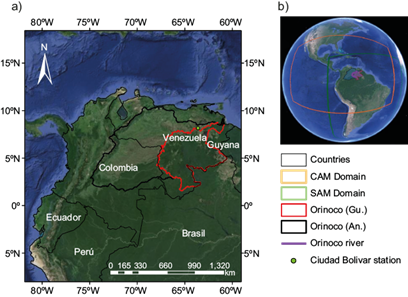
Fig. 1 (a) Study region: the Orinoco River basin on northern South America (black: Andean slope; red: Guiana Shield). (b) Context of the CORDEX-CORE domains for South and Central America (CAM/SAM)
Divided into three main sections, the basin encompasses the Alto Orinoco in the south, characterized by the Ventuari as its primary tributary; the Medio Orinoco, predominantly located within the Colombian Orinoco region and featuring tributaries like Inirida, Vichada, Guaviare, Meta, and Arauca; and finally, the Bajo Orinoco near the delta, where the Caroni and Caura emerge as the most significant tributaries (Silva, 2005; Frappart et al., 2012). Additionally, the Orinoco River basin shares a border with the Amazon River basin, with both basins acting as crucial sources of Andean sediments and dissolved rare elements feeding into the Atlantic Ocean (Meade, 2008; Mora et al., 2020).
The precipitation patterns in the Orinoco River basin showcase a distinctive unimodal annual cycle, marked by a dry season during December-January-February (DJF) and a contrasting wet season spanning June-July-August (JJA) (Labar et al., 2005; Urrea et al., 2019). Notably, the hydroclimatology during DJF is predominantly influenced by the Orinoco Low-Level Jet (OLLJ), which contributes to the dry season through low-level wind divergences (Labar et al., 2005; Jiménez-Sánchez et al., 2019; Builes-Jaramillo et al., 2022; Martínez et al., 2022). Conversely, the Cross-Equatorial Flow (CEF) plays a pivotal role during JJA, transporting moisture from the Amazon River basin to the Orinoco River basin and thereby causing the wet season (Builes-Jaramillo et al., 2022; Wang and Fu, 2002). Despite its crucial role in the hydroclimate of northern South America, the Orinoco River has received limited attention in recent decades, with scarce efforts directed towards estimating its long-term water balance (Silva, 2005).
While studies analyzing climate change trends within Venezuela and Colombia exist (Falloon and Betts, 2006; Brêda et al., 2020, Arias et al., 2021; Miranda et al., 2023; Viloria et al., 2023), a comprehensive analysis of historical trends in hydrological variables specifically emphasizing the impact of the Andes and Guiana Shield mountain ranges on the basin’s surface runoff, and integrating downscaled information is noticeably absent. Hence, regional climate models (RCMs) offer an alternative to global climate models (GCMs), as RCMs can simulate higher spatial resolutions, providing more intricate representations of climatic features for smaller areas. Notably, the Coordinated Regional Downscaling Experiment (CORDEX) serves as a key resource for this endeavor. Within CORDEX, the Coordinated Output for Regional Evaluations (CORDEX-CORE) initiative aims to provide consistent projections across several planetary domains, using a core set of RCMs driven by common GCMs with standardized simulation protocols (Remedio et al., 2019; Giorgi et al., 2021). For the CORDEX-CORE experiment, two RCMs, namely RegCM4 (Giorgi et al., 2012) and REMO (Pietikäinen et al., 2018), have been implemented.
CORDEX-CORE has implemented several domains around the world, particularly for northern South America. The South America (SAM) and Central America (CAM) domains are useful for regional climate change assessments. According to the literature, RCMs in the CAM domain have a better performance in reproducing air-sea interactions, leading to better representation of key circulation patterns such as the Intertropical Convergence Zone (ITCZ) and reduced precipitation over land and oceans (Remedio et al., 2019; Cavazos et al., 2020), as well as in coastal regions. In contrast, SAM domain simulations show less precision due to the Andes high altitudes (Jacob et al., 2012; Ashfaq et al., 2021; Reboita et al., 2021).
Recognizing the potential for an in-depth analysis of the Orinoco River basin, we studied the historical long-term surface water balance in the basin addressing the following questions: (a) how do the estimates of long-term basin balance differ when utilizing models and remote sensing ensembled with reanalysis datasets?; (b) are there discernible trends in hydrological variables across the Orinoco basin for the historical period of 1981-2014?; (c) which mountain range exerts a greater influence on surface runoff in the basin, the Andes or the Guianese shield?; (d) do the CORDEX-CORE RCMs effectively represent the surface water balance of the Orinoco River basin?; and (e) among the RCM ensembles from the CORDEX-CORE experiment, which demonstrate optimal performance in representing precipitation patterns?
Furthermore, in anticipation of future climate scenarios for the basin, the study aims to explore: (a) how do precipitation trends unfold under the future climate change scenario RCP8.5 during the period 2060-2100; and (b) if there is a notable alteration in long-term mean precipitation between the future climate change scenario RCP8.5 for 2060-2100 and the historical period 1981-2014.
This work is organized as follows: section 2 outlines the datasets and methods adopted for the surface water balance analysis, model selection, and bias correction; section 3 presents the results and ensuing discussions, and section 4 concludes the study and presents future work.
2. Datasets and methods
The present study is divided into three main stages:
Analysis of the historical long-term water balance and historical trends in the variables of the Orinoco River basin with state-of-the-art datasets.
Analysis of the performance of historical scenarios from the CORDEX-CORE RCMS.
Analysis of the projected changes in the hydrological cycle over the Orinoco River basin.
2.1 Reference datasets
As a reference, we use monthly datasets gridded for precipitation (P) and total evaporation (E) at 0.25º × 0.25º for the common period 1981-2014. For precipitation, we use three datasets: (i) atmospheric reanalysis ERA5 (Hersbach et al., 2020), (ii) Global Precipitation Climatology Centre Full Data Reanalysis (GPCC) v. 7 (Schneider et al., 2014), and (iii) Climate Hazards Group InfraRed Precipitation with Station (CHIRPS) (Funk et al., 2015). For total evaporation, we use three datasets: (i) ERA5, (ii) Global Evaporation Amsterdam Model (GLEAM) (Martens et al., 2017), and (iii) Global Land Data Assimilation System (GLDAS) (Rodell et al., 2004). For the streamflow of the Orinoco River basin, we use the time series at the Ciudad Bolívar gauge for 2003-2010, which is obtained from the So-Hybam project website (HyBAm, 2023).
2.2 CORDEX-CORE
The CORDEX-CORE simulation framework includes the implementation of two RCMs driven by at least three GCMs in each domain. The RegCM4 and REMO models are the RCMs available for the SAM and CAM domains, while Table I lists the GCMs downscaled by each RCM. The study area is located in the northernmost SAM domain, while for the CAM domain it is located in a more central position, which implies an overlapping position between the domains (Fig. 1). Although different basins are situated between these domains, there is a lack of performance analysis between the SAM and CAM runs. Each model run was gridded to a 0.25º × 0.25º common grid, using bilinear interpolation (Accadia et al., 2003) for the ease of comparison. In total, we have a dataset of 12 downscaled model runs, six for each domain (CAM/SAM). We calculated multi-member ensembles as the mean value of reference datasets (Ens-Ref), and each RCM implementation in each domain: (i) RegCM-SAM, (ii) RegCM-CAM, (iii) REMO-SAM, and (iv) REMO-CAM. Hence, every ensemble is composed of three members. Multi-member ensembles are useful to lower the model uncertainties of each RCM implementation at a seasonal time scale (Hagedorn et al., 2005).
Table I CORDEX-CORE datasets: HadGEM2-ES (Martin et al., 2011), MPI-ESM-LR (Giorgetta et al., 2013), NorESM1-M (Bentsen et al., 2013), and GFDL-ESM2M (Dunne et al., 2012).
| Domain | SAM | CAM | ||
| RCM | RegCM4 | REMO | RegCM4 | REMO |
| GCM1 | HadGEM2-ES | HadGEM2-ES | HadGEM2-ES | HadGEM2-ES |
| GCM2 | MPI-ESM-LR | MPI-ESM-LR | MPI-ESM-LR | MPI-ESM-LR |
| GCM3 | NorESM1-M | NorESM1-M | GFDL-ESM2M | NorESM1-M |
2.3 Present long-term surface water balance and trends
The long-term surface water balance was quantified using Eq. [1], where P is the mean precipitation in the basin and E is the mean total evaporation (Peixoto and Oort, 1993; Marengo, 2005; Zhang et al., 2008), acknowledging that this approach is the simplest one and that its selection is based on the size of the basin (> 500 × 103 km2) and the length of observations (> 30 years). Therefore, this approach is useful under the assumption that for large areas, subterranean runoff is negligible as the storage rate is for long periods. Once we know the performance of the reference datasets, we achieve two goals: (i) to update the long-term balance of the Orinoco River basin using state-of-the-art datasets, and (ii) to produce an ensemble for precipitation to be used as a reference for comparison analysis with the historical runs of the RCMs. The runoff (R) was computed as R = Q/A (Builes-Jaramillo and Poveda, 2018), where Q represents the long-term monthly mean streamflow and A is the area of the river basin (860 000 km2 at the Ciudad Bolivar gauge). Then, the estimations of Q using RCMs are compared with the observed long-term mean streamflow in the Ciudad Bolívar gauge and previous works (Silva, 2005).
We computed Kendall’s non-parametric test (Kendall, 1975) for a monotonic trend using the Theil-Sen method (Sen, 1968) to estimate the slope in each grid point for P and E.
2.4 Andes-Guiana runoff
The long-term surface runoff (R) is computed as the difference of the long-term mean of P and E for the total area of the river basin, as well as for the river basin divided into two sections (Fig. 1): (a) the Andean section of the basin that includes sub-basins located in the eastern Andean mountain range territory (609 652 km2); and (b) the Guiana section, which includes sub-basins located in the Guianese shield territory (250 347 km2). The separation of the basin into two portions helps to identify if there is an imbalance in terms of the water runoff that feeds the river streamflow.
2.5 Model performance assessment method
Using the ERA5, GPCC, and CHIRPS precipitation datasets, we compute an ensemble that serves as a reference. Then, we calculate the mean spatial correlation between the reference ensemble and the CORDEX-CORE historical simulations to assess the models’ performance. Moreover, we compute the Arcsin M (Eq. [2]) skill metric (Watterson et al., 2014; Solman and Blázquez, 2019) for each RCM/domain ensemble.
where MSE is the mean square error between the modeled and observation fields, Y and X, respectively. Furthermore, V is the variance and G is the mean. The final factor provides a skill score that has a maximum possible value of 1000 (for MSE = 0). With the M performance metric and spatial correlations, we will be able to select the models with best performance in the region.
2.6 Bias correction method
Once we found the CORDEX-CORE model ensemble with the best performance, we chose it in order to perform the bias correction. For that RCM ensemble, we downloaded the simulations for the RCP8.5 scenario for the period 2060-2100, regionalized by the CORDEX-CORE experiment. These simulations are bias-corrected according to the delta (Eq. [3]) and linear scaling (Eq. [4]) methods as proposed by Teutschbein and Seibert (2012). We selected these two methods for the bias correction because they are robust for long-term monthly analysis (Brêda et al., 2020), as the one in the present study.
where PBC is the monthly bias corrected precipitation, P r is the observed precipitation during the historical period, P f is the simulated precipitation for the future period, P sp the simulated precipitation for the historical period, and µ m (∙)the mean monthly value for the simulation or observation periods. It is worth noting that the delta method is applied to correct the bias in the observed dataset, whereas the linear scaling method is applied to correct the bias in the simulated future.
With the bias-corrected datasets, we compute annual cycles and spatial biases between the RCP8.5 projections and reference dataset ensembles. In this way, we are able to assess the seasons when future projections show changes in water availability and where there will be greater perturbations in the Orinoco River basin.
3. Results
3.1 Long-term surface water balance and trends
Figure 2 shows the mean fields and trends of P and E from the reference datasets ensembles for the Orinoco River basin. According to the reference datasets ensemble, the lower values of mean P in the basin are located in central Venezuela, with values from 50 to 80 mm month-1, whereas the highest values of mean P in the eastern flanks of the Andes and the Guianese shield had values from 200 to 230 mm month-1, which highlight the importance of the two mountain ranges for precipitation in the Orinoco River basin (Fig. 2a). In terms of trends (Fig. 2c), our results suggest that P decreases in the north and northeastern basin territory (-0.5 mm decade-1) and eastern flanks of the Andes (-1.0 to -1.5 mm decade-1), while P shows positive trends in the south of the basin (1.0-2.0 mm decade-1).
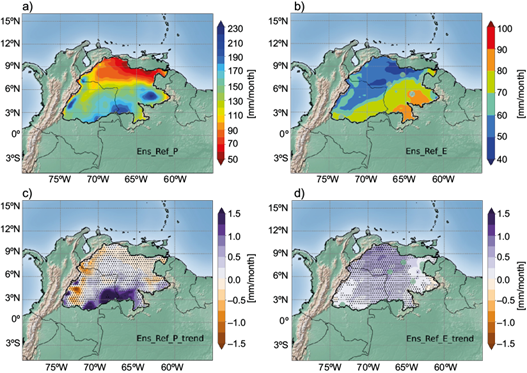
Fig. 2 Mean fields from the reference datasets ensemble during the period 1981-2014 for (a) precipitation (P) and (b) total evaporation (E). Trend fields from the reference datasets ensemble during the period 1981-2014 for (c) precipitation (P) and (d) total evaporation (E). Dots in trend fields depict the pixels with a significant trend according to the Theil-Sen method and the Kendall test.
Regarding E, the reference datasets show the highest values in the Guianese shield of the basin (80-90 mm month-1) and the lower values in the Llanos region between Colombia and Venezuela, the eastern flanks of the Andes, and the coastal mountain range in northern Venezuela (values of 40-60 mm month-1) (Fig. 2b). Reference datasets for E show a higher increasing trend in the north of the basin (1.0 mm decade-1), whereas the easternmost portion of the basin exhibits a slight decreasing trend (-0.5 mm month-1) (Fig. 3d). It is worth noting that the north (southeast) of the basin, where there are decreasing (increasing) trends in P, is the same region with increasing (decreasing) trends in E.
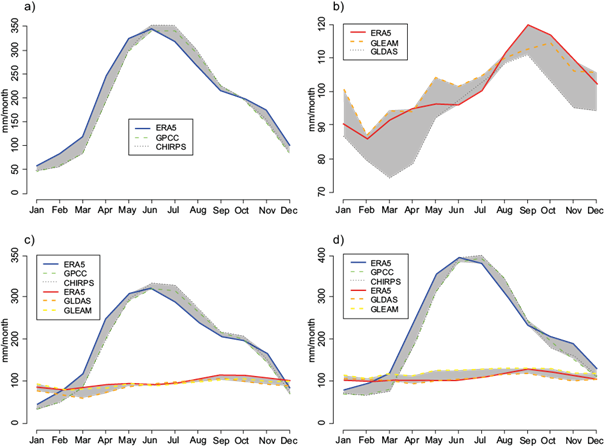
Fig. 3 Annual cycles of reference datasets over the Orinoco basin (in mm month-1). (a) Precipitation, (b) total evaporation, (c) precipitation and total evaporation over the Andean portion of the Orinoco basin, and (d) precipitation and total evaporation over the Guiana portion of the Orinoco basin. The grey area shows the dataset’s variability.
The annual cycles of both P and E are shown in Figure 3. All datasets represent the unimodal annual cycle for P in the basin, with the highest values between June-July (around 350 mm month-1) and lowest values in January (50 mm month-1) (Fig. 3a). In terms of E, data sources show less evaporation from January to May (in the range 75-90 mm month-1) than from June to September (110-120 mm month-1) (Fig. 3b). An analogous analysis was carried out considering the river basin in their Andean and Guianese territories separately.
In Figure 3c, d it is evident that the annual cycles of P are similar in shape (unimodal, peaking around midyear); however, the Andean portion of the basin shows a lower peak (300 mm month-1) than the one exhibited by the Guianese portion of the basin (400 mm month-1). In January, we found that P is also lower in the Andean portion of the basin (50 mm month-1) than in the Guianese portion (100 mm month-1). We present a schematic summary of the results for the entire basin and for the two portions in Figure 4, including the accumulated monthly values computed from the ensemble of reference datasets for P and E. In general, the Andean and Guianese portions of the basin generate the same amount of runoff, with differences lower than 1%. This shows the importance of both mountainous regions for the hydrological stability of the basin.
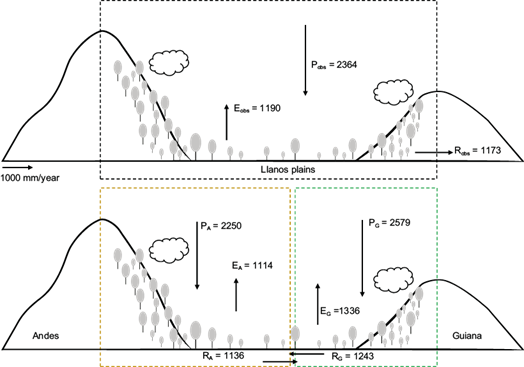
Fig. 4 Schematic representation of the Orinoco River basin considering its Andean and Guianese portions. Top panel: water balance computation for all the Orinoco River basin. Bottom panel; water balance for the Andean (yellow dashed box) and Guianese (green dashed box) portions separately. P, E and R depict the long-term accumulated values of the components in the water balance equation (in mm year-1).
We computed the long-term streamflow for the reference datasets ensembles of P and E (Table II). Our results suggest that the differences between streamflow observations at the Ciudad Bolívar gauge and those by Silva (2005) are negligible (-4.8% to -6.1%). This result shows that by means of model ensembles, it is possible to obtain a robust representation of the long-term water balance. However, previous analyses for total evaporation and evapotranspiration products over South America have proven to possess significant shortcomings in the simulation of this variable (Sörensson and Ruscica, 2018; Builes-Jaramillo and Pántano, 2021); therefore, a good long-term closure of the surface water balance is not enough to decide on the performance of the regional models. Hence, hereafter we assess the model selection by using only the P ensemble.
Table II Runoff computed from the long-term water balance equation for the entire basin and the two portions.
| P-E/Q (dataset) | P-E (mm/year) | Q (m3/s) | Difference Q (%) |
| P-E (PR-ER) | 1,173 | 31,996 | |
| Q (So-Hybam) | 1,249 | 34,069 | -6.1 |
| P-E/QSilva León, (2005) | 1,145 | 33,600 | -4.8 |
PR: ensemble value computed from the ERA5, CHIRPS, and GPCC datasets; ER: ensemble value computed from the ERA5, GLDAS, and GLEAM datasets.
3.2 Model selection
We computed the REMO and RegCM RCMs ensembles in the CAM and SAM CORDEX-CORE domains. Thus, we have ensembles from: (i) RegCM- SAM, (ii) RegCM-CAM, (iii) REMO-SAM, and (iv) REMO-CAM. Figure 5a shows the annual cycle of P for the reference ensemble (CHIRPS, GPCC, and ERA5) and the ensemble of the RCMs models. On one hand, the best performance for the annual cycle of P simulated by models is over the SAM domain (red lines), although there is a mean underestimation of P for the reference period of the SAM ensembles of around 25%. On the other hand, the ensembles computed from the models over the CAM domain (blue lines) fail to simulate the annual cycle of P in terms of its magnitude and variability, with an underestimation of nearly 40% in the wet season (April-September). In the bias field of the best RCM representation of the annual cycle (REMO-SAM ensemble) (Fig. 5b), we can observe regions where P is overestimated (100-300 mm month-1) by the RCM ensemble, contrary to the annual cycles shown in Figure 5a, which exhibit an underestimation by the REMO-SAM ensemble during the entire year.
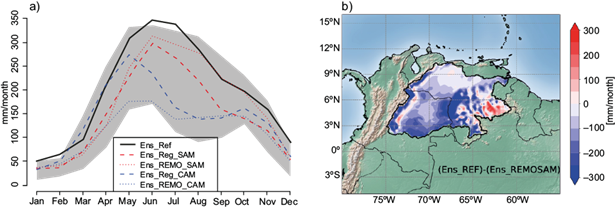
Fig. 5 (a) Annual cycles of precipitation (in mm month-1) for the ensembles of reference datasets and available models from CORDEX-CORE over the Orinoco River basin. The grey area shows the ensembles inter member variability. (b) Precipitation bias field with respect to the reference dataset from the REMO-SAM ensemble for the historical period 1981-2014.
The biases are computed as the ensemble of reference datasets minus each one of the model ensembles (Ens-Rref). Figure 6a shows that models underestimate precipitation (positive values) elsewhere than the eastern flank of the Andes mountain range and the Guianese shield (negative values). The highest underestimation (overestimation) of P is given by the REMO-CAM (REMO-SAM) ensemble. Furthermore, Figure 6b shows the spatial Pearson’s correlation between reference and RCM ensembles over the river basin. In general, the higher correlations are found in the Llanos region between Colombia and Venezuela, while the lower correlations are located in the Andean flanks, the outflow zone (delta), and the southern portion of the basin.
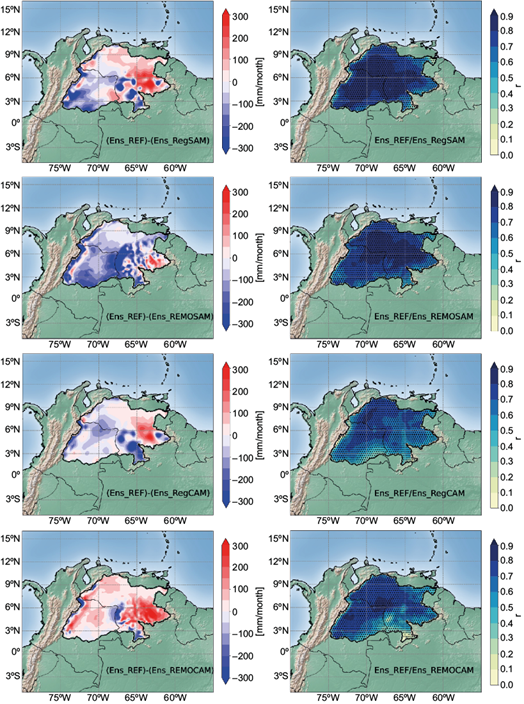
Fig. 6 Left column: fields of precipitation bias for each one of the RCM/domain ensembles. Right column: correlation between the reference datasets ensemble and each one of the RCM/domain ensembles. Correlations are for the monthly time series in each domain pixel. Dots in the correlation fields denote a 95% significance.
Figure 6 evidences a lower bias and higher spatial correlations for the RegCM model (RegCM-CAM-RegCM-SAM). Table III includes the results for the Arcsin M and the mean spatial correlation r for the entire basin. M exhibits higher values (closer to 1000) for the REMO model in both CAM and SAM domains, whereas r shows higher values for the RegCM and REMO models in the CAM and SAM domains, respectively. Moreover, we computed the M and r metrics for the wet and dry seasons, April-September and October-March, respectively, to assess the skill of RCMs to represent the periods of high and low precipitation throughout the year. During the dry season, we found a better performance for the ensembles over the CAM domain. After an overall model ensemble analysis, the best performance skill during the wet season was found for the REMO model ensembles regardless of the domain. Therefore, we selected the REMO-SAM to assess the future projections of P according to the RCP8.5 scenario included in the CORDEX-CORE experiment for its lower underestimation of the annual cycle variability (19%; Fig. 5a) and higher values of M and r (Table II). Hence, previous results suggest that the REMO-SAM model presents a better performance simulating P in the basin.
Table III Arcsin Mielke M and spatial correlation r for all model ensembles during the study period 1981-2014 and for the wet and dry seasons over the basin.
| Long-term estimation | Dry season | Wet season | ||||
| Ensemble | M | r | Md | rd | Mw | rw |
| RegCM-CAM | 561 | 0.76 | 770 | 0.66 | 809 | 0.20 |
| REMO-CAM | 727 | 0.66 | 781 | 0.63 | 829 | 0.23 |
| RegCM-SAM | 697 | 0.64 | 608 | 0.62 | 756 | 0.48 |
| REMO-SAM | 718 | 0.75 | 752 | 0.67 | 828 | 0.41 |
M d/w: Arsin Mielke M during the dry (wet) season; r d/w: spatial correlation during the dry (wet) season.
3.3 Future precipitation over the Orinoco River basin
We used the REMO-SAM ensemble to assess changes in precipitation according to the RCP8.5 scenario. Figure 7a shows that, in terms of annual variability representation, annual precipitation cycles for the future period 2060-2100 without bias correction (red line) are similar to the one found for the historical period in the SAM domain (green line), with a reduction in the simulated precipitation for all the year. After bias correction of the RCP8.5 simulations (Fig. 7a, purple lines), we found reductions in the magnitude of monthly P ranging from 40 to 60% regarding the precipitation quantified for the historical period. According to Brêda et al. (2020), the mean reductions in precipitation for northern South America and the Orinoco basin are higher than 35% based on CMIP5 simulations for the RCP8.5 scenario. In particular, for the REMO-SAM ensemble, the percentage of change is computed as the bias-corrected precipitation minus the reference precipitation data set divided by the reference (Fig. 7b). The percent of change in the basin is higher during September-October, at the onset of the dry season. The mean underestimation of precipitation for the future period is 42% for the delta method bias-corrected ensemble and 47% for the linear scaling bias-corrected ensemble.
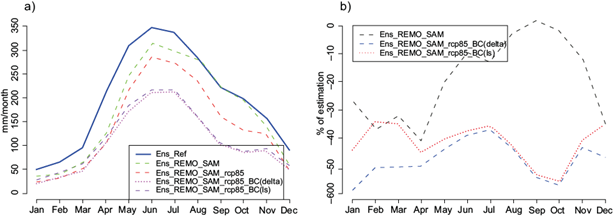
Fig. 7 (a) Annual cycles of Precipitation in mm month-1 from the ensemble of reference datasets and ensembles of the REMO Regional Model for the SAM region (historical, future, and bias-corrected). (b) Estimation of monthly precipitation as a percentage of the mean precipitation observed in the reference datasets.
Figure 8 presents the precipitation bias between the reference and future periods for the REMO-SAM ensembles, using bias correction. Figure 8 shows that for the RCP8.5 scenario, REMO tends to underestimate precipitation in the mountainous regions of the Andes and the Guianese Shield, whereas it is overestimated in parts of the Llanos lowlands and south of the Guianese shield. Figure 8a, b shows that both bias-corrected ensembles agree for the future period simulated by the REMO-SAM ensemble (RCP8.5 scenario). The higher reductions of precipitation are located in the Guianese (around 300 mm month-1) portion and in the eastern flanks of the Andes (around 150 mm month-1). Moreover, according to the REMO-SAM ensembles, our results suggest that precipitation increases in the Llanos corridor between Colombia and Venezuela (around 50 mm month-1). In Figure 8c, we compare the spatial differences between the two bias-correction methods; the higher differences are found in the Llanos and southern Guianese shield.
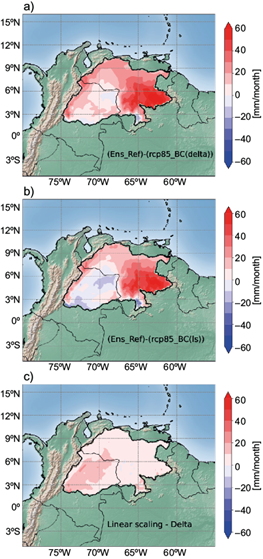
Fig. 8 Bias fields of precipitation with respect to the reference dataset from: (a) bias-corrected REMO-SAM ensemble for the rcp85 scenario with the delta method; (b) bias-corrected REMO-SAM ensemble for the rcp85 scenario with the linear scaling method, and (c) bias between mean fields of bias-corrected simulations (linear scaling-delta).
4. Conclusions and future work
We investigated the present and future hydro-climatology of the Orinoco River basin, one of the most relevant basins in South America but, paradoxically, one of the least studied in terms of future hydro-climatology scenarios. We updated the surface water balance of the basin with several state-of-the-art gridded datasets and estimated long-term trends for these variables. Also, we analyzed the importance of the Andean and Guianese portions of the basin in terms of water production. In this sense, we found that the regions with negative precipitation trends are, in fact, those with positive total evaporation trends for the long term and that each mentioned mountainous portion of the basin constitutes approximately half of the total runoff, which highlights the importance of the mountain ranges for the water production and hydrological stability of the basin. Our results provide new insights into the relevance of the Guianese portion, which is only 30% of the total area of the basin but accounts for 50% of the surface runoff, and also gives further evidence of the importance of the Andes for the stability of the two biggest basins of northern South America, the Amazon (Builes-Jaramillo and Poveda, 2018) and the Orinoco River basin.
For the historical period 1981-2014, we found that the reference datasets reproduce the general features of the annual cycle for precipitation. However, total evaporation exhibits shortcomings and discrepancies that have been previously mentioned for diverse datasets in South America (Sörensson and Ruscica, 2018; Builes-Jaramillo and Pántano, 2021). Furthermore, P and E exhibit increasing trends, which provide evidence of perturbations in the hydrological cycle of the basin, a hydroclimate feature that has also been reported for the Amazon River basin (Gloor et al., 2013; Barichivich et al., 2018). Notwithstanding, the reference datasets ensemble adequately represents the runoff and mean streamflow of the basin with errors below 7%. Thus, recent developments in remote sensing become an important tool for providing hydroclimatological information for the basin scale; nevertheless, this approach may not be suitable for smaller basins or finer timescales, as observational datasets are needed for bias correction or validation.
We assessed the performance of the regional climate CORDEX-CORE models over the basin for the Central America (CAM) and South America (SAM) domains. Our results suggest that precipitation is underestimated over the SAM domain the whole year, although it is fairly represented, while for the CAM domain precipitation is underestimated during the wet season at around 40%. In general, all ensembles exhibit shortcomings in the representation of precipitation over the Andean slopes and the Guianese shield. We selected the REMO-SAM ensemble because of its better skill according to the Arcsin M metric, spatial correlations, and annual cycle representation. We are aware that selecting one model as the correct one may result in false positives, which is why we have used several metrics to evaluate the performance. Another approach could be to do the ensemble with all the models available after discarding those more evidently wrong.
For the future RCP8.5 scenario 2060-2100, we found, after bias correction of the datasets, that precipitation reduces between 42 and 47% for the REMO-SAM ensemble during the May to October period, which can be interpreted as a reduction of the rainy season or as an abrupt change in the magnitude of precipitation in the period of transition between wet and dry season. This result agrees with the projections of reductions higher than 35% reported by Brêda et al. (2020) for northern South America based on CMIP5 GCMs. Those reductions of almost half of the precipitation around the year in the region, also reported by Arias et al. (2023), added to the ongoing trend of deforestation in the Guianese rainforest, could enhance the severity of droughts in the basin (Sorí et al., 2023) and accelerate the savannisation of the region (Valencia et al., 2023). These alterations could lead to a reduction of the water vapor flux from the Atlantic Ocean towards the Amazon basin (Nieto et al., 2008; Bovolo et al., 2018) that transit through the Orinoco River basin; a reduction of the outflow of precipitation from the Orinoco basin towards Northern South America via moisture recycling (Hoyos et al., 2018; Escobar et al., 2022); extreme precipitation events (Martínez et al., 2023), or even the role of Central America as an evaporative source (Durán-Quesada et al., 2017).
Our results of a decreased mean precipitation in the Orinoco River basin, based on CORDEX-CORE (CMIP5), agrees with the AR6 regional analysis for northern South America, which reports medium confidence on the decrease of mean precipitation for the tropical region (Sun et al., 2019; IPCC, 2021a, b). Given this context, efforts in the region derived from the AR7 assessment report could be oriented to improve the representation of the land/atmosphere feedback to better comprehend the impacts on water availability that sustains the basin’s fragile ecosystems. As part of future work, we propose conducting a comprehensive, long-term evaluation by comparing observational datasets, GCMs from the CMIP6 run, and the newly regionalized generation of GCMs across basins of diverse sizes. This analysis will encompass both historical and future scenarios, enabling us to establish a confidence level to identify suitable models for accurately representing the hydroclimatology of each basin based on its specific area.











 nueva página del texto (beta)
nueva página del texto (beta)


